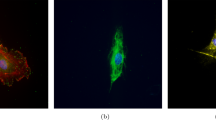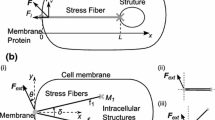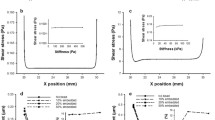Abstract
Hemodynamic forces applied at the apical surface of vascular endothelial cells may be redistributed to and amplified at remote intracellular organelles and protein complexes where they are transduced to biochemical signals. In this study we sought to quantify the effects of cellular material inhomogeneities and discrete attachment points on intracellular stresses resulting from physiological fluid flow. Steady-state shear- and magnetic bead-induced stress, strain, and displacement distributions were determined from finite-element stress analysis of a cell-specific, multicomponent elastic continuum model developed from multimodal fluorescence images of confluent endothelial cell (EC) monolayers and their nuclei. Focal adhesion locations and areas were determined from quantitative total internal reflection fluorescence microscopy and verified using green fluorescence protein–focal adhesion kinase (GFP–FAK). The model predicts that shear stress induces small heterogeneous deformations of the endothelial cell cytoplasm on the order of <100 nm. However, strain and stress were amplified 10–100-fold over apical values in and around the high-modulus nucleus and near focal adhesions (FAs) and stress distributions depended on flow direction. The presence of a 0.4 μm glycocalyx was predicted to increase intracellular stresses by ∼2-fold. The model of magnetic bead twisting rheometry also predicted heterogeneous stress, strain, and displacement fields resulting from material heterogeneities and FAs. Thus, large differences in moduli between the nucleus and cytoplasm and the juxtaposition of constrained regions (e.g. FAs) and unattached regions provide two mechanisms of stress amplification in sheared endothelial cells. Such phenomena may play a role in subcellular localization of early mechanotransduction events.









Similar content being viewed by others
References
Adamson R. H., G. Clough (1992) Plasma proteins modify the endothelial cell glycocalyx of frog mesenteric microvessels. J. Physiol. 445:473–486
Barbee K. A., T. Mundel, R. Lal, P. F. Davies (1995) Subcellular distribution of shear stress at the surface of flow-aligned, nonaligned endothelial monolayers. Am. J. Physiol. Heart Circ. Physiol. 268:H1765–H1772
Bursac P., G. Lenormand, B. Fabry, M. Oliver, D. A. Weitz, V. Viasnoff, J. P. Butler, J. J. Fredberg (2005) Cytoskeletal remodelling, slow dynamics in the living cell. Nat. Mater. 4:557–561
Butler P. J., G. Norwich, S. Weinbaum, S. Chien (2001) Shear stress induces a time-, position-dependent increase in endothelial cell membrane fluidity. Am. J. Physiol. Cell Physiol. 280:C962–C969
Butler, P. J., T. C. Tsou, J. Y. Li, S. Usami, and S. Chien. Rate sensitivity of shear-induced changes in the lateral diffusion of endothelial cell membrane lipids: A role for membrane perturbation in shear-induced MAPK activation. FASEB J. 16(2):216–218, 2001
Butler P. J., S. Weinbaum, S. Chien, D. E. Lemons (2000) Endothelium-dependent, shear-induced vasodilation is rate-sensitive. Microcirculation 7:53–65
Caille N., O. Thoumine, Y. Tardy, J. J. Meister (2002) Contribution of the nucleus to the mechanical properties of endothelial cells. J. Biomech. 35:177–187
Charras G. T., M. A. Horton (2002) Determination of cellular strains by combined atomic force microscopy, finite element modeling. Biophys. J. 83:858–879
Charras G. T., B. A. Williams, S. M. Sims, M. A. Horton (2004) Estimating the sensitivity of mechanosensitive ion channels to membrane strain, tension. Biophys. J. 87:2870–2884
Charras G. T., J. C. Yarrow, M. A. Horton, L. Mahadevan, T. J. Mitchison (2005) Non-equilibration of hydrostatic pressure in blebbing cells. Nature 435:365–369
Davies P. F. (1995) Flow-mediated endothelial mechanotransduction. [Review] [407 refs]. Physiol. Rev. 75:519–560
Davies P. F., A. Robotewskyj, M. L. Griem (1994) Quantitative studies of endothelial cell adhesion. Directional remodeling of focal adhesion sites in response to flow forces. J. Clin. Invest. 93:2031–2038
Deguchi S., K. Maeda, T. Ohashi, M. Sato (2005) Flow-induced hardening of endothelial nucleus as an intracellular stress-bearing organelle. J. Biomech. 38:1751–1759
DePaola N., M. A. Gimbrone Jr., P. F. Davies, C. F. Dewey Jr. (1992) Vascular endothelium responds to fluid shear stress gradients. Arterioscler. Thromb. 12:1254–1257
Ferko, M. C., B. P. Patterson, P. J. Butler. (2006) High-resolution solid modeling of biological samples imaged with 3D fluorescence microscopy. Microsc. Res. Tech. 69(8):648–655.
Florian J. A., J. R. Kosky, K. Ainslie, Z. Pang, R. O. Dull, J. M. Tarbell (2003) Heparan sulfate proteoglycan is a mechanosensor on endothelial cells. Circ. Res. 93:e136–e142
Frangos J. A., T. Y. Huang, C. B. Clark (1996) Steady shear, step changes in shear stimulate endothelium via independent mechanisms-superposition of transient and sustained nitric oxide production. Biochem. Biophys. Res. Commun. 224:660–665
Frank P. G., M. P. Lisanti (2006) Role of caveolin-1 in the regulation of the vascular shear stress response. J. Clin. Invest. 116:1222–1225
Fujiwara K., M. Masuda, M. Osawa, Y. Kano, K. Katoh (2001) Is PECAM-1 a mechanoresponsive molecule? Cell Struct. Funct. 26:11–17
Galbraith C. G., R. Skalak, S. Chien (1998) Shear stress induces spatial reorganization of the endothelial cell cytoskeleton. Cell Motil. Cytoskeleton 40:317–330
Gudi S. R., C. B. Clark, J. A. Frangos (1996) Fluid flow rapidly activates G proteins in human endothelial cells. Involvement of G proteins in mechanochemical signal transduction. Circ. Res. 79:834–839
Haidekker M. A., N. L’Heureux, J. A. Frangos (2000) Fluid shear stress increases membrane fluidity in endothelial cells: A study with DCVJ fluorescence. Am. J. Physiol. Heart Circ. Physiol. 278:H1401–H1406
Helmke B. P., R. D. Goldman, P. F. Davies (2000) Rapid displacement of vimentin intermediate filaments in living endothelial cells exposed to flow. Circ. Res. 86:745–752
Helmke B. P., A. B. Rosen, P. F. Davies (2003) Mapping mechanical strain of an endogenous cytoskeletal network in living endothelial cells. Biophys. J. 84:2691–2699
Hu S., J. Chen, B. Fabry, Y. Numaguchi, A. Gouldstone, D. E. Ingber, J. J. Fredberg, J. P. Butler, N. Wang (2003) Intracellular stress tomography reveals stress focusing, structural anisotropy in cytoskeleton of living cells. Am. J. Physiol. Cell Physiol. 285:C1082–C1090
Hu S., L. Eberhard, J. Chen, J. C. Love, J. P. Butler, J. J. Fredberg, G. M. Whitesides, N. Wang (2004) Mechanical anisotropy of adherent cells probed by a three-dimensional magnetic twisting device. Am. J. Physiol. Cell Physiol. 287:C1184–C1191
Jalali S., M. A. del Pozo, K. Chen, H. Miao, Y. Li, M. A. Schwartz, J. Y. Shyy, S. Chien (2001) Integrin-mediated mechanotransduction requires its dynamic interaction with specific extracellular matrix (ECM) ligands. Proc. Natl. Acad. Sci. USA 98:1042–1046
Jean R. P., C. S. Chen, A. A. Spector (2005) Finite-element analysis of the adhesion-cytoskeleton-nucleus mechanotransduction pathway during endothelial cell rounding: axisymmetric model. J. Biomech. Eng. 127:594–600
Jean R. P., D. S. Gray, A. A. Spector, C. S. Chen (2004) Characterization of the nuclear deformation caused by changes in endothelial cell shape. J. Biomech. Eng. 126:552–558
Karcher H., J. Lammerding, H. Huang, R. T. Lee, R. D. Kamm, M. R. Kaazempur-Mofrad (2003) A three-dimensional viscoelastic model for cell deformation with experimental verification. Biophys. J. 85:3336–3349
Koller A., G. Kaley (1991) Endothelial regulation of wall shear stress, blood flow in skeletal muscle microcirculation. Am. J. Physiol. 260:H862–H868
Laudadio R. E., E. J. Millet, B. Fabry, S. S. An, J. P. Butler, J. J. Fredberg (2005) Rat airway smooth muscle cell during actin modulation: Rheology, glassy dynamics. Am. J. Physiol. Cell Physiol. 289:C1388–C1395
Li S., P. Butler, Y. Wang, Y. Hu, D. C. Han, S. Usami, J. L. Guan, S. Chien (2002) The role of the dynamics of focal adhesion kinase in the mechanotaxis of endothelial cells. Proc. Natl. Acad. Sci. USA 99:3546–3551
Mack P. J., M. R. Kaazempur-Mofrad, H. Karcher, R. T. Lee, R. D. Kamm (2004) Force-induced focal adhesion translocation: Effects of force amplitude, frequency. Am. J. Physiol. Cell Physiol. 287:C954–C962
Mijailovich S. M., M. Kojic, M. Zivkovic, B. Fabry, J. J. Fredberg (2002) A finite element model of cell deformation during magnetic bead twisting. J. Appl. Physiol. 93:1429–1436
Mochizuki S., H. Vink, O. Hiramatsu, T. Kajita, F. Shigeto, J. A. Spaan, F. Kajiya (2003) Role of hyaluronic acid glycosaminoglycans in shear-induced endothelium-derived nitric oxide release. Am. J. Physiol. Heart Circ. Physiol. 285:H722–H726
Nerem R. M., M. J. Levesque, J. F. Cornhill (1981) Vascular endothelial morphology as an indicator of the pattern of blood flow. J. Biomech. Eng. 103:172–176
Ohayon J., P. Tracqui, R. Fodil, S. Fereol, V. M. Laurent, E. Planus, D. Isabey (2004) Analysis of nonlinear responses of adherent epithelial cells probed by magnetic bead twisting: A finite element model based on a homogenization approach. J. Biomech. Eng 126:685–698
Olivier L. A., J. Yen, W. M. Reichert, G. A. Truskey (1999) Short-term cell/substrate contact dynamics of subconfluent endothelial cells following exposure to laminar flow. Biotechnol. Prog. 15:33–42
Pourati J., A. Maniotis, D. Spiegel, J. L. Schaffer, J. P. Butler, J. J. Fredberg, D. E. Ingber, D. Stamenovic, N. Wang (1998) Is cytoskeletal tension a major determinant of cell deformability in adherent endothelial cells? Am. J. Physiol. 274:C1283–C1289
Radel C., V. Rizzo (2005) Integrin mechanotransduction stimulates caveolin-1 phosphorylation recruitment of Csk to mediate actin reorganization. Am. J. Physiol. Heart Circ. Physiol. 288:H936–H945
Reilly G. C., T. R. Haut, C. E. Yellowley, H. J. Donahue, C. R. Jacobs (2003) Fluid flow induced PGE2 release by bone cells is reduced by glycocalyx degradation whereas calcium signals are not. Biorheology 40:591–603
Rizzo V., A. Sung, P. Oh, J. E. Schnitzer (1998) Rapid mechanotransduction in situ at the luminal cell surface of vascular endothelium, its caveolae. J. Biol. Chem. 273:26323–26329
Sato M., M. J. Levesque, R. M. Nerem (1987) An application of the micropipette technique to the measurement of mechanical properties of cultured bovine aortic endothelial cells. J. Biomech. Eng. 109:27–34
Sato M., K. Nagayama, N. Kataoka, M. Sasaki, K. Hane (2000) Local mechanical properties measured by atomic force microscopy for cultured bovine endothelial cells exposed to shear stress. J. Biomech. 33:127–135
Stamenovic, D., N. Wang, and D. E. Ingber. Tensegrity models of cell-substrate interactions. In King, M. R. (ed.) Principles of Cellular Engineering: Understanding the Biomolecular Interface. 81–101, 2006
Sund S. E., J. A. Swanson, D. Axelrod (1999) Cell membrane orientation visualized by olarized total internal reflection fluorescence. Biophys. J. 77:2266–2283
Tarbell J. M., M. Y. Pahakis (2006) Mechanotransduction, the glycocalyx. J. Intern. Med. 259:339–350
Thi M. M., J. M. Tarbell, S. Weinbaum, D. C. Spray (2004) The role of the glycocalyx in reorganization of the actin cytoskeleton under fluid shear stress: A “bumper-car” model. Proc. Natl. Acad. Sci. USA 101:16483–16488
Trickey W. R., F. P. Baaijens, T. A. Laursen, L. G. Alexopoulos, F. Guilak (2006) Determination of the Poisson’s ratio of the cell: Recovery properties of chondrocytes after release from complete micropipette aspiration. J. Biomech. 39:78–87
Truskey G. A., J. S. Burmeister, E. Grapa, W. M. Reichert (1992) Total internal reflection fluorescence microscopy (TIRFM). II. Topographical mapping of relative cell/substratum separation distances. J. Cell Sci. 103 (Pt 2):491–499
Tzima E., M. Irani-Tehrani, W. B. Kiosses, E. Dejana, D. A. Schultz, B. Engelhardt, G. Cao, H. DeLisser, M. A. Schwartz (2005) A mechanosensory complex that mediates the endothelial cell response to fluid shear stress. Nature 437:426–431
Wang N., J. P. Butler, D. E. Ingber (1993) Mechanotransduction across the cell surface, through the cytoskeleton. Science 260:1124–1127
Wang N., Z. Suo (2005) Long-distance propagation of forces in a cell. Biochem. Biophys. Res. Commun. 328:1133–1138
Weinbaum S., X. Zhang, Y. Han, H. Vink, S. C. Cowin (2003) Mechanotransduction, flow across the endothelial glycocalyx. Proc. Natl. Acad. Sci. USA 100:7988–7995
Zaidel-Bar R., Z. Kam, B. Geiger (2005) Polarized downregulation of the paxillin-p130CAS-Rac1 pathway induced by shear flow. J. Cell Sci. 118:3997–4007
Acknowledgments
This work was supported in part by a grant to PJB from the National Heart Lung and Blood Institute (R01 HL 077542-01A1), by a National Science Foundation Career Award to PJB (BES 0238910), and by a seed grant from the Center for Optical Technologies, Bethlehem, PA. GFP–FAK was a gift from Song Li, Ph.D., University of California, Berkeley. MBG was supported by the Penn State Biomaterials and Bionanotechnology Summer Institute (NIBIB-NSF EEC 0234026).
Author information
Authors and Affiliations
Corresponding author
Additional information
An erratum to this article is available at http://dx.doi.org/10.1007/s10439-007-9280-3.
Rights and permissions
About this article
Cite this article
Ferko, M.C., Bhatnagar, A., Garcia, M.B. et al. Finite-Element Stress Analysis of a Multicomponent Model of Sheared and Focally-Adhered Endothelial Cells. Ann Biomed Eng 35, 208–223 (2007). https://doi.org/10.1007/s10439-006-9223-4
Received:
Accepted:
Published:
Issue Date:
DOI: https://doi.org/10.1007/s10439-006-9223-4




